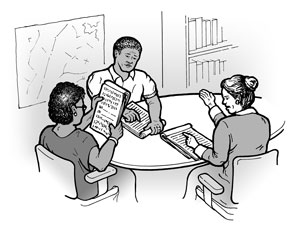This list of reminders can serve as a guide to presenting meeting content in an accessible way.
- Invitation Information: Include in the invitation clear information about the meeting's accessibility, which tells a prospective participant with a disability that the host understands the issues and that the guest will feel welcomed, comfortable, and able to participate fully in the meeting. Information should include the accessibility of the meeting's location, how to request services for the meeting (e.g., Braille, sign language interpreters, readers), and accessible means to respond to the invitation (e.g., telephone,TTY, text messaging, email).
Written Agenda: Provide a written agenda along with the invitation. Agendas help not only to direct the content of the meeting but also to assist participants in anticipating topics and following the meeting flow. Include beginning and ending times of the meeting to assist people in scheduling accessible transportation and quantifying the time required for participation.
Agendas help everyone follow the flow of the meeting.
- Key Meeting Points: Writing key points from the presentations and discussion on a blackboad or easel-mounted chart pad helps everyone follow the meeting's proceedings.
- Auxiliary Aids and Services: If auxiliary aids and services are requested by guests, meeting organizers will need to address before the meeting takes place how to provide such services as interpreters, realtime captioning, and notetakers. For information about how to respond to requests for auxiliary aids and services, see Providing Auxiliary Aids and Services
- Providing Background Information to People with Sensory Disabilities: At the beginning of the meeting, ask all participants to introduce themselves. This not only serves as an ice-breaker, but also lets people who are blind or have low vision know who is at the meeting. Ask participants to talk one at a time and identify themselves during the discussion so that participants who are blind or have low vision and participants who are deaf or have hearing loss (through the realtime captioner or the interpreter) know who is speaking.
- Audiovisual Presentations: If a presentation includes audiovisuals (e.g., computer presentation, video, or printed charts and graphics), it will be necessary to have the visuals described for people who are blind or have low vision. Audio description does not have to be presented separately. The speaker can describe visuals as part of her lecture. It will be helpful to presenters who are not trained audiodescribers to talk with participants who are blind or have low vision beforehand about the type and level of detail that is useful. If the presentation is provided to participants in print, the handouts must also be accessible.
It is also necessary to have the narration captioned or interpreted for guests who are deaf or have hearing loss. Where there is no captioning on the audiovisual itself, interpreters or realtime captioners can help supply the text.


User Comments/Questions
Add Comment/Question